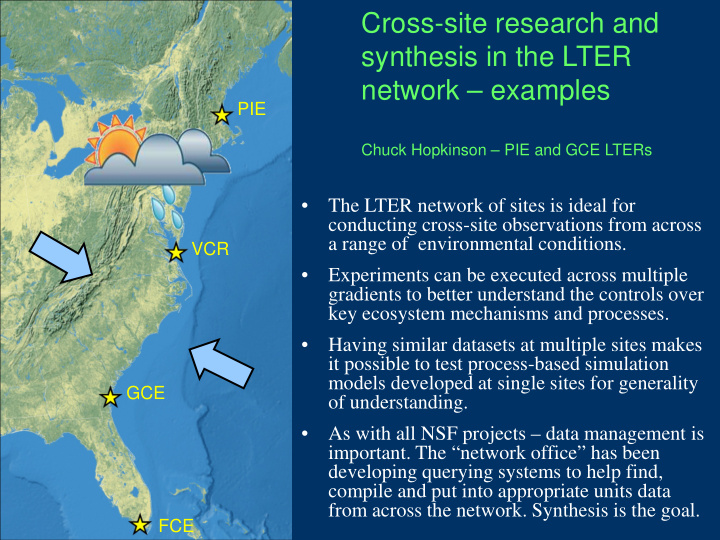



Cross-site research and synthesis in the LTER network – examples PIE Chuck Hopkinson – PIE and GCE LTERs • The LTER network of sites is ideal for conducting cross-site observations from across a range of environmental conditions. VCR • Experiments can be executed across multiple gradients to better understand the controls over key ecosystem mechanisms and processes. • Having similar datasets at multiple sites makes it possible to test process-based simulation models developed at single sites for generality GCE of understanding. • As with all NSF projects – data management is important. The “network office” has been developing querying systems to help find, compile and put into appropriate units data from across the network. Synthesis is the goal. FCE
Example 1: Coastal SEES: Wetland Vulnerability to Sea-level Rise McGlathery, Alber, Giblin, Johnston, Kirwan, Wiberg, Morris, Alexander, Polsky How will feedbacks between marsh response to SLR and human adaptation responses affect sustainability of the socio-ecological system? PIE VCR GCE
Coastal SEES: Wetland Vulnerability to Sea-level Rise 1) how marsh vulnerability to current and projected SLR, with and without adaptation actions, compares across biogeographic provinces and a range of biophysical and social drivers 2) which marsh protection actions local stakeholder groups favor, and what are the broader sustainability and economic value implications of feasible adaptation options.
Coastal SEES: Wetland Vulnerability to Sea-level Rise Plausible scenarios of historically stable marshes under future SLR (E) Threshold rates of SLR not crossed, marsh transgression exceeds marsh loss. (D) Threshold rates of SLR not crossed, or marsh transgression balances marsh loss (e.g. VCR). (C) Threshold rates of SLR crossed, (A) Threshold rates of but rapid marsh loss spurs adaptive SLR crossed, uplands management (dam removal, are armored to prevent managed transgression) that allows marsh transgression. some marshes to persist. Rates of marsh loss are rapid (e.g. PIE). (B) Threshold rates of SLR crossed, uplands armored, but physical factors slow marsh loss (e.g. GCE).
Example 2: Controls of Terrestrial Productivity
Each site shows a linear response to water availability. Only through cross-site research was this basic non-linear functional understanding revealed. • Water availability limits plant growth in all terrestrial systems, but biomes differ in sensitivity of ANPP to precipitation • In years when water is most limiting, all terrestrial systems exhibit the same rate of ANPP per unit rainfall, despite differences in physiognomy. Huxman et al.
Example 3: Long-term Intersite Decomposition Experiment Team (LIDET) A 10-year field study testing the degree to which substrate quality and climate control the long-term carbon and nitrogen dynamics of decomposing leaf and fine root litter. LIDET employed a standardized methodology at 27sites to examine decomposition patterns of 30 species of litter. Leaf litter bags Root litter bags Source: M. E. Harmon and LIDET
Example 4: Detritus Inputs & Forest Soil Organic Matter Formation: Is There a Linear Relationship Between Detrital Input Rates and Soil Carbon Accumulation? 816 Pg C 1417 Pg C 497 Pg C Global Atmospheric, Biomass and Soil Carbon Pools Source: Nadelhoffer for DIRT
Will increases in NPP translate into increased soil organic carbon storage? Multifactor experiment conducted at multiple sites in US and Europe
Example 5: What city is this: Phoenix or Boston? Source: Groffman for Urban Homogenization
Six study cities, 14 co- pi’s, 11 institutions: • Why do our cities look so similar? • What are the effects of this urban homogenization on: – Biodiversity – Soil biogeochemistry (carbon, nitrogen) – Hydrography – Microclimate – Quality of life
Example 6: General understanding of abrupt state shifts Cross-site analysis of LTER time series data from 4 sites to: 1) Assess analytically whether & when abrupt transitions occurred 2) Evaluate proposed methods of forecasting abrupt shifts 3) Seek evidence of hysteresis JRN LTER California Current Palmer Station Santa Barbara Jornada Basin Ecosystem LTER Antarctica LTER Coastal LTER LTER Source: Schmitt for the team
Evidence for mode of the abrupt transition (e.g., Hysteresis) Examined relationships between response & driver variables Hysteresis mechanism? Likely mode (identified by LTER studies) Krill Positive predation- mediated feedback Sea Cucumber Positive predator- & breeding-mediated Penguins feedbacks Positive feedback Black Grama between soil erosion & Grass JRN LTER low grass cover
U.S. LTER Network Questions? 25 sites representing diverse biomes, including terrestrial, aquatic, & human-dominated ecosystems
Recommend
More recommend